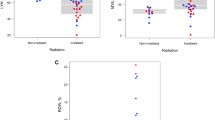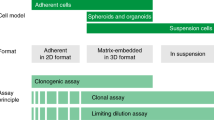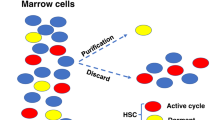Abstract
IF mice are heavily irradiated, injected intravenously with an appropriate suspension of haematopoietic cells and killed 1–2 weeks later, prominent nodules can be seen on the surface of the spleen1. Microscopically, the nodules are foci of intense cellular proliferation and are commonly termed colonies. The linear relationship between the numbers of cells injected and the numbers of colonies observed1 and the exponential reduction of numbers of colonies with increasing dose when irradiated cells are injected1,2 suggested that each colony could be a clone of cells derived from a single progenitor cell in the inoculum1. Becker et al.3 provided direct evidence of clonal origin by irradiating recipients before and after injection, then finding individual colonies in which most mitotic cells had the same uniquely abnormal karyotype. This result has been supported by other experiments using marker chromosomes4–6. We now offer evidence that a single cell from the donor may give rise to two, three or four colonies in the irradiated recipient.
This is a preview of subscription content, access via your institution
Access options
Subscribe to this journal
Receive 51 print issues and online access
$199.00 per year
only $3.90 per issue
Buy this article
- Purchase on Springer Link
- Instant access to full article PDF
Prices may be subject to local taxes which are calculated during checkout
Similar content being viewed by others
References
Till, J. E., and McCulloch, E. A., Radiat. Res., 14, 213 (1961).
McCulloch, E. A., and Till, J. E., Radiat. Res., 16, 822 (1962).
Becker, A. J., McCulloch, E. A., and Till, J. E., Nature, 197, 452 (1963).
Wu, A. M., Till, J. E., Simminovitch, L., and McCulloch, E. A., J. Cell. Physiol., 69, 177 (1967).
Welshons, W., in Mammalian Cylogenelics and Related Problems in Radiobiology (edit. by Pavan, C., Ghagas, C, Froa-Pessoa, O., and Caldas L. R.), 123 (Pergamon Press, London, 1964).
Chen, M. G., and Schooley, J. C., Transplantation, 6, 121 (1968).
Corp, M. J., and Mole, R. H., Radiat. Res., 16, 66 (1962).
Ford, C. E., in Cytogenetics of Cells in Culture (edit. by Harris, R. J. C.), 27 (Academic Press, New York, 1964).
Curry, J. L., and Trentin, J. J., Dev. Biol., 15, 395 (1967).
Author information
Authors and Affiliations
Rights and permissions
About this article
Cite this article
BARNES, D., EVANS, E., FORD, C. et al. Spleen Colonies in Mice: Karyotypic Evidence of Multiple Colonies from Single Cells. Nature 219, 518–520 (1968). https://doi.org/10.1038/219518a0
Received:
Revised:
Issue Date:
DOI: https://doi.org/10.1038/219518a0
This article is cited by
-
Introduction of new genetic material into pluripotent haematopoietic stem cells of the mouse
Nature (1984)
-
Chromosomal analysis of inactivation of stem cells by transplantation of mixed bone marrow from genetically different donors
Bulletin of Experimental Biology and Medicine (1970)
Comments
By submitting a comment you agree to abide by our Terms and Community Guidelines. If you find something abusive or that does not comply with our terms or guidelines please flag it as inappropriate.



